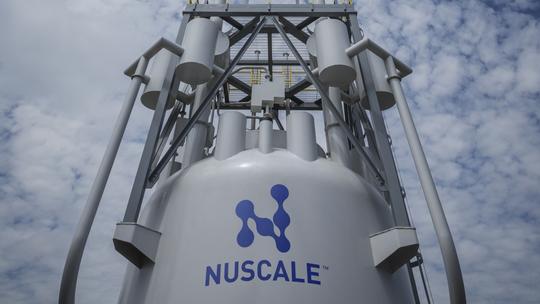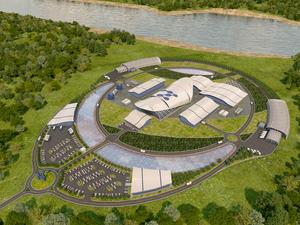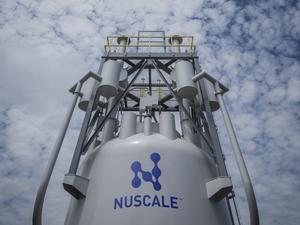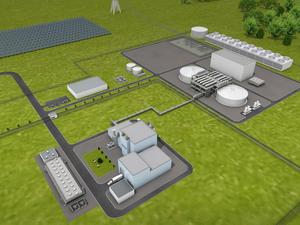
With its planned public listing drawing near, NuScale Power is defying recent market disdain for special purpose acquisition company mergers. Investors have done nothing but warm to the Portland-based nuclear startup and its tie-up with the SPAC Spring Valley Acquisition Corp. in recent weeks.
Exhibit 1: The deal has attracted $55 million in additional private investment since it was announced in December.
Exhibit 2: Spring Valley stock (Nasdaq: SV), which gives investors a path into NuScale, ended trading Wednesday at $11.10, a peak close. That’s well above its standard $10 opening SPAC price at a time when many peers are below that mark.
Exhibit 3: Spring Valley warrants, which give holders the right to purchase the stock at $11.50 a share, have had a big run-up, from around $1 when the merger was announced to $3 now.
Exhibit 4: A public-private partnership from Japan purchased an 8-9% piece of NuScale from majority owner Fluor Corp. (NYSE: FLR) for $110 million.
“It’s a clean energy SPAC that in a very bad stock market for SPACs is performing very well,” Arthur Hyde, a portfolio manager and partner at Segra Capital Management, said.
A SPAC raises money from investors and goes public as a shell company, then targets a private company to merge with and take public. Through Spring Valley, NuScale is aiming for a listing on the New York Stock Exchange under the ticker symbol SMR, and IPO proceeds of upwards of $400 million.
Segra was among a handful of firms that together provided $181 million in private investment in public equity, or PIPE, to the NuScale-Spring Valley deal when it was announced. Since then, the PIPE has swollen to $236 million. Spring Valley itself brings $232 million into the deal, although its investors have the option of redeeming their shares for their money back plus interest before the deal close.
Redemptions have been running high for SPACs after many performed poorly in the “de-SPACing” process and newly public companies saw their stocks sink. But that may not be the case with NuScale, although it won’t be known for sure until the deal closes. A shareholder vote on the merger has been set for April 28.
“It’s incredibly positive to see other intelligent clean-energy investors see what we see in the promise of NuScale, alongside core industrial partners and potential customers,” Hyde said. “I think it’s a further validation of the business model.”
Segra began looking closely at nuclear around 2018, Hyde said, at a time when the sector wasn’t getting much love from investors. A better sense of the deep decarbonization challenge has shifted views, he believes, and Russia’s invasion of Ukraine has accelerated interest in fossil-fuel alternatives.
Segra’s nuclear power-focused fund now has about $300 million in assets under management.
“If you look at the clean-energy transition, we’re not going to do it with wind, solar and batteries alone,” Hyde said. “People often lose what makes nuclear different. It’s not just the dispatchable nature. If we really want to get to carbon neutral, it’s very difficult to produce clean hydrogen, produce process heat for industrial applications or address a number of economically important functions that nuclear can solve for. From our perspective, a lot of the hard-to-solve areas of the economy when it comes to decarbonization get much, much easier with nuclear.”
That was underscored by the recent $15 million NuScale investment from steel giant Nucor Corp., whose CEO said it was looking for “safe and reliable sources of power generation that are consistent with our sustainability goals.”
Segra has talked up nuclear as a sector with environmental, social and governance investment cred.
“It can’t be overstated how important the acknowledgement that nuclear is an ESG investment is becoming,” Hyde said. “The ESG story for nuclear is finally being recognized, and we’re in a market where ESG continues to be a major driver of capital and investor interest.”
Nuclear development had drawn skepticism in the U.S. based partly on a large-scale Georgia project going seriously sideways, massively behind schedule and over cost. NuScale backers brush aside skepticism that it will suffer a similar fate.
“We’re talking about factory-built, much smaller, much more scalable, much less site-specific design,” Hyde said. “The future of nuclear in the West may not be large-scale reactors, unless we really dedicate to a national build program, but a lot of the promise of the new technology is driven by the economics, scalability and flexibility that comes from a modular build plan designed for factory fabrication.”
At the same time, Hyde maintains, the technology isn’t really untested.
“There are clearly benefits to being smaller, but NuScale’s technology benefits from being built on the same light-water framework that the U.S. has operated, safely and efficiently, for 70 years,” he said. “Detractors can always paint it as risky because the first units will be first of its kind, but for any technology, there’s always a first. The first iPhone, the first Tesla, the first solar panel — they faced the same challenges out of the gate. That’s how world-changing technologies start.”
Whether NuScale can fulfill its promise is a story that will likely take several years to play out. But for now, it stands as an investment opportunity for those who believe in nuclear power’s necessity and prospects.
“NuScale will be one of the few pure play nuclear investment opportunity in public markets,” Hyde said. “It’s ahead of its peers in terms of licensing process, customer order book development and technology. They’re far beyond a proof of concept. I think it’s definitely a lighting rod for investors focused on the nuclear industry.”






